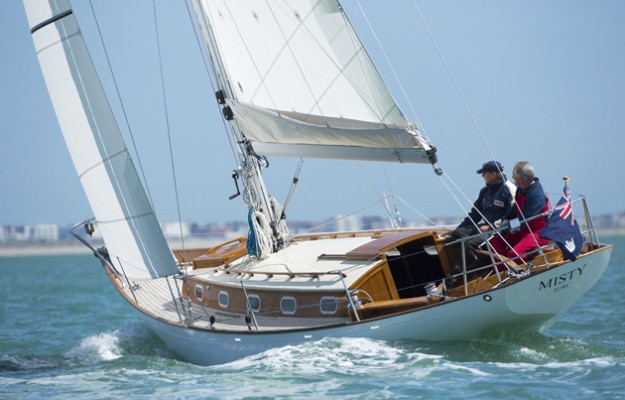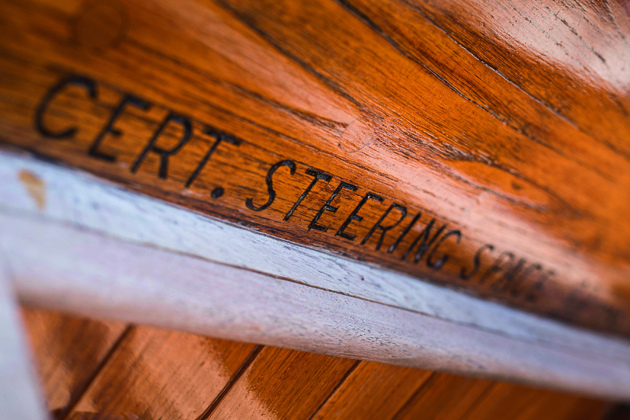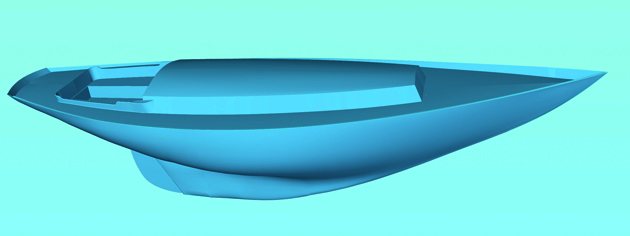A 37-footer from the 1960s with racing pedigree, Misty was reworked for the classic circuit. Rupert Holmes reports on her extensive refit
Sailing Misty
Although Stephen Card sought to make Misty’s new rig as efficient for IRC as possible, he opted for a traditional deck layout to show off the boat’s clean lines. He carried this through to the extent of removing the windlass and hawse pipe for the anchor chain.
Similarly, other than a well-concealed pilot control, there are no instrument repeaters on deck or below – instead an iPad connected to a system from Digital Yacht is used to view relevant information.
After the rebuild, Misty was delivered by road to the River Hamble, where the new rig was stepped before she went to the Southampton Boat Show and was then put under wraps for the winter. Misty’s first real outing was therefore a shakedown in the JOG race to Cherbourg at Easter this year.
We sailed Misty in a brisk south-westerly breeze gusting over 20 knots on a gloriously sunny Solent day. She demonstrated the typical reassuring solid gait of a heavy-displacement, long-keel design with a soft motion upwind in the Solent chop and a beautifully balanced helm.
With a non-overlapping jib set, we tucked in the first reef going upwind in 15-18 knots of true wind and, though predictably not able to point as well as a modern design, she made respectable boat speed. Under spinnaker in a building breeze she proved surprisingly responsive on the helm as the boat speed nudged upwards of 7.5 knots – significantly faster than theoretical hull speed.
Misty had originally been wheel-steered, although during the rebuild she was converted to a tiller which, perhaps ironically, in today’s terms appears to be more in keeping with the boat’s style. It was certainly clear that even in fairly breezy conditions loads on the helm are not excessive and there’s therefore no need for a wheel. In addition, given that Misty’s narrow cockpit would only allow a small wheel to be fitted, steering with a tiller extension allows a much better view of the headsail luff.
Sailing with Card, I realised that his predilection for racing may not have been his main motivation for restoring Misty, though it certainly has a bearing on his plans for the boat. Once Card returns from this year’s Azores and Back race on his other boat, a Class 40, the immediate future for Misty is likely to be racing in classic regattas, both in the UK and potentially further afield.
However, Card also hankers after a larger vessel – he first saw Misty at the same time as he was negotiating, unsuccessfully, to buy a 55ft 10-metre class. He is therefore contemplating selling both his boats and restoring a bigger classic yacht that will have more space for his large family (he has five daughters).
It certainly seems as though, despite the considerable costs of undertaking a restoration to such a high standard, he enjoyed the process so much he would be happy to do it again.
Laser scanning
This offers the opportunity to create a three-dimensional surface model of yachts designed before the software tools today’s naval architects use became available. The data from the scan can be used to give accurate stability calculations and as the input for velocity prediction programs.
The equipment is expensive, but the time-saving is enormous compared with measuring by hand and the accuracy is also significantly improved. Marcus Evans says that most 40ft yachts can be measured to within 2mm tolerances in a couple of hours – working with Nicola Sironi of the ORC technical staff, he completed measurements on two large Wallys in around four hours each.
This is an extract from a feature in the July 2015 issue of Yachting World







